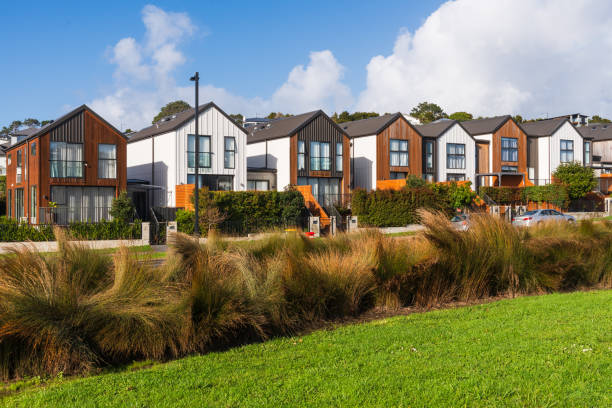Los Angeles needs more housing, and the city knows it. That’s why the Citywide Housing Incentive Program (CHIP) was introduced. It’s part of a broader effort to encourage developers, homeowners, and investors to create housing that meets local demand — and to make the permitting process faster and more predictable.
Table of Contents
ToggleAt JDJ Consulting Group, we often hear clients ask: “Does CHIP really make permits faster?” or “Can my project qualify for incentives?”
This guide breaks down the program in simple terms. We’ll explain how CHIP affects planning, zoning, and permitting. You’ll see what incentives it offers and where our consulting team adds value. Whether you’re a developer, architect, or property owner, you’ll find clear answers and practical advice here.
What Is CHIP? A Deep Look at the Citywide Housing Incentive Program
CHIP stands for Citywide Housing Incentive Program. It’s an L.A. City Planning program that encourages the construction of new housing — especially affordable and mixed-income units — in areas already served by transit and infrastructure.
In short, the city created CHIP to:
- Make housing development more attractive in the right places.
- Give developers flexibility through zoning and density incentives.
- Speed up approvals for qualified projects.
- Help Los Angeles meet its housing production goals under the Housing Element plan.
Many people confuse CHIP with the State Density Bonus Program, but they’re not identical. CHIP works alongside state law, offering a local layer of incentives designed to match Los Angeles’ own zoning rules.
Here’s how CHIP compares to other housing programs:
| Program | Level | Main Purpose | Key Benefit |
| State Density Bonus | California (Statewide) | Encourage affordable units through bonus density | Up to 50% more units allowed |
| CHIP | City of Los Angeles | Align incentives with city zoning and community plans | Tailored local bonuses, faster review |
| Transit-Oriented Communities (TOC) | City of Los Angeles | Promote housing near major transit stops | Tiered incentives based on distance to transit |
Essentially, CHIP brings together several older housing incentive programs and standardizes them. It helps create one consistent process that reduces guesswork for developers and staff.
For property owners, this means you no longer need to figure out which local incentive applies to your lot. CHIP gives you a unified path to pursue added units, reduced parking, or relaxed setbacks — as long as you meet the program’s eligibility rules.
The Specific CHIP Incentives That Affect Permits and Project Scope
The most common question we hear is: “What do I actually get under CHIP?”
The answer depends on your project’s location, zoning, and affordability commitment. But the incentives generally fall into three groups: density and design bonuses, streamlined approvals, and cost-related benefits.

Density and Design Incentives
Developers can often build more units or taller buildings than zoning would normally allow. The trade-off is providing a portion of the units as affordable housing.
Typical design incentives may include:
- Increased floor-area ratio (FAR)
- Additional height or stories
- Reduced open-space requirements
- Flexible setbacks or lot coverage adjustments
The goal is simple: make mixed-income and affordable projects financially feasible without compromising neighborhood quality.
Here’s a quick summary of how those benefits look in practice:
| Project Type | Standard Zoning Allowance | Possible CHIP Incentive | Result |
| Multifamily near major transit | 4 stories / 1.5 FAR | +2 stories, FAR up to 2.5 | More units, less parking required |
| Mixed-use with affordable units | Commercial zoning, 3 floors | Height bonus + reduced setbacks | More leasable space, improved feasibility |
| Adaptive reuse of older building | Strict parking & open-space rules | Waivers for parking and open-space | Lower retrofit cost, faster approval |
Streamlined Review and Approval
CHIP also creates a faster path through the entitlement and permitting process. Instead of multiple discretionary reviews, qualifying projects often use a ministerial review — meaning approvals are based on set criteria rather than public hearings.
This cuts down months of waiting time, especially for smaller infill and affordable projects. For most applicants, that’s where a permit expeditor or planning consultant adds the most value.
When we help a client through CHIP, we typically focus on:
- Verifying eligibility early through site and zoning research.
- Preparing all required forms and affordability documentation.
- Coordinating with LADBS and Planning reviewers to prevent delays.
Fee and Parking Incentives
The city also recognizes that parking and permitting fees can make projects unaffordable. CHIP can reduce those burdens through:
- Lower parking minimums for transit-adjacent sites.
- Streamlined review fees for qualifying housing projects.
- Flexibility in open-space or setback design that saves buildable area.
For developers, these small changes can have a major effect on total cost per unit.
Who Qualifies and Where CHIP Applies
Not every property or project in Los Angeles can use CHIP. The program targets areas where new housing makes the most sense — near transit, jobs, and existing infrastructure. It also focuses on mixed-income development that includes at least some affordable housing.
The good news is that CHIP covers a wide part of the city. Many parcels that were once limited by older zoning rules may now qualify for added density or a faster review.
Zoning and Location Requirements
To qualify, a property must be in a zone that allows residential or mixed-use construction. CHIP works best in multi-family, commercial, and transit-oriented zones.
Here’s a quick overview of where CHIP typically applies:
- Transit-rich areas: parcels near bus or rail stops, often with reduced parking needs.
- Commercial corridors: streets where housing above retail or office space fits city goals.
- Mixed-income neighborhoods: areas where a mix of market-rate and affordable units is encouraged.
Projects located in hillside zones, flood zones, or Very High Fire Hazard Severity Areas often face restrictions. Similarly, homes inside Historic Preservation Overlay Zones (HPOZs) may not qualify for CHIP incentives.
Project Types That Qualify
CHIP incentives are designed for a range of housing models. Qualifying projects include:
- Multi-family developments (apartments, condos, mixed-use buildings).
- Adaptive reuse of older or underused commercial buildings.
- Affordable or mixed-income projects meeting city affordability standards.
- Infill housing that adds new units on vacant or underutilized lots.
In some cases, smaller developers or even property owners can use CHIP for ADUs or small-lot subdivisions, but the benefits are more limited.
Eligibility Checklist
Before starting your permit application, it’s smart to review the key eligibility boxes you’ll need to check:
| Eligibility Factor | Requirement | Notes |
| Zoning | Residential or mixed-use zone | Verify with zoning map (ZIMAS) |
| Location | Within a designated CHIP area | Often near transit or urban centers |
| Affordable Units | Must include qualifying affordable percentage | Usually 10–20% of total units |
| Compliance Covenant | Recorded affordability covenant required | Managed by LA Housing Department |
| Site Restrictions | Avoid HPOZs, hillsides, or high fire zones | Case-by-case exceptions possible |
If your project meets these points, you’re likely eligible for at least one CHIP incentive tier.
At JDJ Consulting Group, we help clients confirm eligibility early — before design work begins. This prevents wasted time on zoning that won’t qualify.
How CHIP Changes the Permitting Workflow
One of the biggest advantages of CHIP is the time it saves. Developers in Los Angeles know that entitlement and permitting can take months — sometimes over a year. CHIP aims to change that by creating a more predictable and faster review process for qualified projects.
From Concept to Pre-Application
Every CHIP project starts with a pre-application review through Los Angeles City Planning. This stage helps determine:
- Whether your site qualifies under the program.
- Which incentives you can request.
- What affordable housing commitments are required.
At JDJ Consulting Group, our zoning consultants often prepare preliminary site studies and zoning summaries before this meeting. These materials speed up the city’s review and reduce back-and-forth later.

Entitlement and Plan Check Process
After the pre-application, your project moves into entitlement review. Here, CHIP offers a major benefit — ministerial approval for qualifying projects.
Ministerial review means your project is approved based on set standards, not discretionary judgment or community hearings. This eliminates delays caused by appeals or political debates.
Once entitlements are confirmed, the project moves into LADBS plan check. CHIP doesn’t skip this step, but it helps by providing:
- Pre-approved zoning bonuses that simplify plan reviews.
- Coordination between LADBS and Planning staff for consistency.
- Clear checklists that reduce requests for corrections.
Inspections and Final Approval
Even with streamlined permitting, inspections still follow standard city procedures. However, projects under CHIP benefit from:
- Coordinated review schedules.
- Faster issuance of Certificates of Occupancy once affordability compliance is verified.
At JDJ Consulting Group, we often assist clients by tracking these milestones and communicating directly with reviewers to prevent administrative delays.
Typical Project Timelines Under CHIP
Here’s a comparison of typical approval timelines for housing projects with and without CHIP incentives:
| Process Stage | Standard Project (Months) | CHIP-Eligible Project (Months) | Time Saved |
| Pre-Application & Eligibility | 2–3 | 1–2 | 1 |
| Entitlement Review | 6–9 | 3–4 | 3–5 |
| LADBS Plan Check | 4–6 | 3–4 | 1–2 |
| Final Inspection & CO | 2–3 | 1–2 | 1 |
| Total Average Duration | 14–21 months | 8–12 months | 6–9 months saved |
For developers, that timeline difference can make or break a project’s financial feasibility. Time saved equals carrying-cost savings, earlier occupancy, and faster return on investment.
How to Apply for CHIP Incentives in Los Angeles
Applying for CHIP incentives isn’t overly complicated, but it requires a clear understanding of your project’s zoning and housing goals. Let’s go through the main steps and what you should prepare before applying.
Step 1: Confirm Zoning and Eligibility
Start by checking if your property is within an eligible area under the Citywide Housing Incentive Program (CHIP) map. You can find this through the Los Angeles City Planning Department website.
Key things to review:
- The base zoning of your site (e.g., R3, C2, RD1.5).
- Whether the property lies within a Transit Priority Area (TPA) or Community Plan Implementation Overlay (CPIO).
- Any conflicting overlays (like hillside or coastal zones) that might limit incentives.
Tip: Always double-check with a land use consultant or permit expeditor familiar with CHIP zones before spending on design work.
Step 2: Prepare Required Documentation
When you’re ready to apply, you’ll need a few essential documents:
- A CHIP Application Form (available through the Planning Department).
- Your site plan, elevations, and unit breakdown prepared by your architect.
- A Housing Incentive Summary Table, showing requested bonuses like height, FAR, or parking reductions.
- A statement of affordable housing commitment, if applicable.
If you’re seeking additional bonuses (such as density or parking reductions), supporting documentation must show compliance with the Los Angeles Municipal Code (LAMC) sections governing affordable housing incentives.
Step 3: Submit to City Planning
After assembling your documents, submit them to the Department of City Planning Development Services Center. Submissions can be made online through the Planning Case Management System (PCMS) or in person for complex projects.
After submission, the application will undergo:
- Initial Review: Staff verifies documents and checks zoning consistency.
- Planning Evaluation: A planner confirms eligibility and prepares findings.
- Final Determination: Once approved, the CHIP incentives are attached to your project entitlements.
This process usually takes between 6–10 weeks, depending on the scope and workload.
Step 4: Coordinate with LADBS for Permitting
Once CHIP incentives are approved, you’ll still need to file for your building permit with the Los Angeles Department of Building and Safety (LADBS).
Here’s what to expect:
- The LADBS team cross-references your CHIP approval during the plan check.
- You’ll be required to include the approved density or height bonuses in your construction drawings.
- If you’re using affordable housing incentives, expect a housing covenant filing through the Housing + Community Investment Department (HCIDLA).
A consultant can often streamline this process by coordinating between LADBS, Planning, and your design team.
Table — Typical Timeline for CHIP Project Approval
| Phase | Typical Duration | Agency Involved | Notes |
| Zoning confirmation | 1–2 weeks | Planning Department | Early review to confirm eligibility |
| CHIP application review | 6–10 weeks | City Planning | Includes incentive verification and findings |
| Housing covenant filing | 2–3 weeks | HCIDLA | Required if affordable units are included |
| Building permit processing | 4–8 weeks | LADBS | Plan check and approval |
Why It Helps to Work with a Consultant
While anyone can file a CHIP application, timing and accuracy matter. Mistakes in zoning interpretation or incomplete forms often cause delays.
A land use consultant ensures:
- You get the maximum incentive available for your property.
- Submissions are complete and compliant from the start.
- You avoid costly rejections or resubmissions.
Many developers find that professional help pays for itself through faster approvals and reduced design revisions.
Common Challenges Developers Face with CHIP Projects
Even though the Citywide Housing Incentive Program (CHIP) simplifies many processes, it still comes with a learning curve. Developers and architects often encounter delays not because their projects are unqualified—but because the details are misunderstood or overlooked.

Here’s what typically causes issues.
-
Misreading the Zoning Layers
Many properties in Los Angeles have multiple zoning overlays, and not all are compatible with CHIP incentives. For instance, a parcel might qualify under the Community Plan Implementation Overlay (CPIO) but also fall within a specific plan area that restricts certain density increases.
If those layers conflict, the City will always apply the more restrictive rule.
That’s why reviewing the property’s zoning record early can prevent unnecessary redesigns later.
Tip: Always confirm with the City Planning’s ZIMAS map and cross-check your site address with the CHIP eligibility layer before assuming bonuses apply.
-
Lack of Coordination Between Planning and Building
Another challenge is the gap between planning approval and building permit review.
A project might receive CHIP incentives—say, an extra two floors—but then run into issues during LADBS plan check if the construction drawings don’t reflect those updates accurately.
This misalignment can delay permitting by weeks.
The best practice is to hold a short pre-permit coordination meeting between your planner, architect, and expeditor once the CHIP determination is issued.
-
Affordable Housing Compliance
Many CHIP projects include affordable units to qualify for higher density or height incentives. However, the Housing + Community Investment Department (HCIDLA) has strict rules about unit size, distribution, and long-term affordability covenants.
Common pitfalls include:
- Mislabeling affordable units on the floor plan.
- Not maintaining required bedroom mix ratios.
- Delaying covenant recordation before plan check.
A missed step here can cause your project’s approval to stall indefinitely until corrected.
-
Public Opposition and Design Review
Some CHIP projects—especially in established neighborhoods—face community resistance during the planning review process. Concerns often involve building height, parking reduction, or density impacts.
If your project triggers a public hearing, it helps to:
- Prepare clear visuals and community-friendly talking points.
- Emphasize housing affordability and local economic benefits.
- Engage an experienced consultant to represent you at hearings.
A professional presentation can often resolve opposition before it delays your case.
Table — Common CHIP Project Roadblocks
| Challenge | Impact | Prevention Strategy |
| Conflicting zoning overlays | Project redesign or delay | Verify all overlays early with City Planning maps |
| Incomplete application | Application returned or delayed | Use checklist from City Planning website |
| Design not updated for incentives | Permit recheck at LADBS | Sync plans immediately after CHIP approval |
| Covenant or HCIDLA delay | Holding up plan check release | Submit housing covenant early in process |
| Community resistance | Hearing delays or revisions | Prepare outreach materials and neighborhood support letters |
-
Cost Uncertainty During Planning
CHIP incentives improve project feasibility, but soft costs can add up during the entitlement and coordination process. For smaller developers, the challenge lies in balancing those costs before construction starts.
A clear budget plan should include:
- Consultant and expeditor fees
- Permit and entitlement costs
- Environmental or traffic study expenses (if triggered)
A good consultant can help identify where to reduce duplication or unnecessary filings—saving both time and money.
When Should You Bring in a Consultant?
Ideally, bring one in before you finalize your site design.
They’ll evaluate how your property can maximize density and minimize delays using CHIP or other programs like TOC or State Density Bonus.
The earlier the coordination starts, the more flexible your design options remain.
CHIP vs. Other Los Angeles Housing Incentive Programs
Los Angeles now offers several incentive options to encourage new housing.
CHIP stands out because it’s flexible, city-specific, and ties incentives to community planning goals rather than just proximity to transit or state rules.

But how does it compare to other major programs like the Transit-Oriented Communities (TOC) and State Density Bonus (SDB)?
Let’s break it down.
-
CHIP (Citywide Housing Incentive Program)
CHIP was created to give Los Angeles more control over how incentives align with local zoning and growth needs.
It’s designed to integrate housing within Community Plan Implementation Overlays (CPIOs) while still keeping flexibility for density, height, and parking reductions.
Best suited for:
- Projects outside of TOC zones
- Sites that align with new community plan updates
- Developers seeking flexibility without full TOC restrictions
-
TOC (Transit-Oriented Communities)
The TOC program focuses on transit proximity—properties within a half-mile of a major bus or rail stop.
It provides tiered bonuses for density, height, and parking reductions, depending on how close the site is to the station.
Best suited for:
- Sites near Metro stations or major corridors
- Mixed-use and multifamily housing projects
- Developers aiming for faster review in eligible zones
-
State Density Bonus (SDB)
This program is statewide and applies to any qualifying housing project in California that provides affordable units.
The SDB program is backed by Government Code Section 65915, which guarantees specific bonuses and concessions to eligible projects.
Best suited for:
- Projects in cities without local incentive programs
- Developers seeking guaranteed, by-right bonuses
- Projects with consistent affordable housing commitments
Table — Comparison of Housing Incentive Programs in Los Angeles
| Feature | CHIP | TOC | State Density Bonus (SDB) |
| Jurisdiction | City of Los Angeles | City of Los Angeles | State of California |
| Eligibility Basis | Community Plan + Local Zoning | Proximity to Transit (½ mile radius) | Affordable Housing Provision |
| Density Bonus | Custom, based on Community Plan policy | Tiered by Transit Access | Set percentages based on state law |
| Parking Incentives | Allowed based on plan consistency | Automatic reductions by tier | By-right reductions |
| Affordable Housing Requirement | Optional or policy-driven | Required | Required |
| Administrative Process | City Planning Review | Streamlined Ministerial Approval | Ministerial (state protection) |
Which Program Works Best for You?
Here’s a simple way to think about it:
- If your project is near a Metro stop, TOC is usually the fastest route.
- If it’s outside transit zones but in a growth corridor, CHIP gives more flexibility.
- If you’re looking for state-level consistency and your city has no local program, SDB is safest.
Many developers in Los Angeles even combine CHIP with SDB provisions for maximum flexibility. That hybrid approach allows them to benefit from local tailoring and state protection at the same time.
Example Scenario
Let’s imagine you own a mid-block property in Van Nuys, zoned C2, about ¾ mile from the nearest Metro line. That’s too far for TOC, but perfect for CHIP. Using CHIP, you could request:
- 25–40% more units
- A height bonus of two additional floors
- Reduced parking ratios
That single adjustment can shift a 30-unit project to 42 units, increasing revenue and improving project feasibility without rezoning.
Table — Example Project Comparison: CHIP vs. TOC vs. SDB
| Scenario | CHIP | TOC | SDB |
| Project Location | Van Nuys (C2 zone) | Koreatown (Tier 3) | Pasadena (Outside LA limits) |
| Base Density (by-right) | 30 units | 35 units | 28 units |
| Bonus Units Added | +12 units (40% increase) | +20 units (60% increase) | +8 units (30% increase) |
| Height Allowed | +2 stories | +3 stories | +1 story |
| Parking Requirement | 1.0 per unit | 0.5 per unit | 0.75 per unit |
Key Takeaway
CHIP adds a new layer of flexibility for developers who were once limited by TOC boundaries or State Density Bonus restrictions.
It gives Los Angeles the ability to shape growth neighborhood by neighborhood—offering more tailored incentives while keeping the process transparent.
How CHIP Supports Affordable and Workforce Housing Goals
Los Angeles continues to face one of the toughest housing affordability crises in the nation.
The Citywide Housing Incentive Program (CHIP) was designed to ease that pressure by encouraging developers to include affordable and workforce units in their projects — without needing to go through complex rezoning or lengthy case filings.
Let’s look at how CHIP directly supports these housing goals.

-
Incentives That Reward Inclusion
CHIP doesn’t just offer one-size-fits-all bonuses. Instead, it rewards projects that bring income diversity to neighborhoods.
Developers who set aside a portion of units for low- or moderate-income households gain access to:
- Additional density or height allowances.
- Reduced parking and open space requirements.
- Priority or expedited review during permitting.
These incentives make it financially realistic to include affordable housing in mid-size and mixed-use developments across the city.
Example: A 50-unit apartment proposal that includes 10 affordable units could qualify for two extra floors and a 30% density bonus under CHIP guidelines.
-
Targeting Workforce-Level Affordability
Los Angeles has long struggled to support the “missing middle” — people who earn too much to qualify for traditional affordable housing but still can’t afford market rents.
CHIP helps bridge that gap by allowing workforce housing projects in zones where other incentive programs don’t apply.
These are typically units for households earning 80–120% of the Area Median Income (AMI).
By including these units, developers can access local benefits even if they don’t qualify for state-level affordable housing programs.
This matters because:
- It keeps essential workers — teachers, nurses, city staff — closer to their jobs.
- It stabilizes neighborhood demographics.
- It supports sustainable urban density goals.
-
Flexibility Across Neighborhood Types
Unlike the TOC program, which focuses on areas near major transit stops, CHIP applies citywide.
That means incentive-based development is now possible in:
- Low-density residential areas where multifamily zoning already exists.
- Commercial corridors looking to add mixed-use or housing above retail.
- Industrial-to-residential transitions, where adaptive reuse projects are feasible.
This flexibility encourages housing production in underused zones, where development costs are lower and community resistance is often milder.
-
Encouraging Sustainable and Inclusive Development
CHIP also supports Los Angeles’ sustainability goals by promoting infill housing that aligns with existing infrastructure and community plans.
Developers who incorporate green building measures, shared open spaces, or active transportation features may qualify for additional plan-level bonuses.
The end goal is not just to build more housing — but to build it smarter, cleaner, and fairer.
Table — Affordable Housing Tiers Supported by CHIP
| Income Category | Percent of Area Median Income (AMI) | Typical Resident Type | Eligible for CHIP Incentives |
| Very Low-Income | Up to 50% AMI | Entry-level workers, part-time staff | Yes |
| Low-Income | 51–80% AMI | Teachers, retail employees | Yes |
| Moderate-Income (Workforce) | 81–120% AMI | Nurses, city employees, first responders | Yes |
| Market Rate | Above 120% AMI | High-income earners | No |
-
Local Economic Benefits
CHIP projects don’t just add housing — they stimulate local economies.
Affordable and workforce housing increases neighborhood stability, supports small businesses, and reduces commute times for local employees.
Over time, this creates more balanced economic growth rather than concentrating development in just a few high-cost corridors.
-
The Role of Developers and Consultants
Developers who understand how to layer CHIP incentives with other programs — like Measure JJJ or state density bonuses — can often achieve more efficient and financially sound projects. This is where consultants make a difference.
They help identify:
- The right mix of income tiers for maximum incentives.
- Overlap between CHIP, TOC, and State Density Bonus eligibility.
- Opportunities for expedited approval or reduced parking.
It’s a technical process, but with proper coordination, it’s also one of the most effective ways to make housing more attainable in Los Angeles.
What This Means for Developers and Investors in 2025 and Beyond
By 2025, Los Angeles’ housing market has shifted toward strategic infill growth rather than high-rise concentration.
Developers who once focused on TOC or State Density Bonus sites are now exploring CHIP-qualified parcels for their next wave of projects.
Let’s look at what this shift means for developers, investors, and the broader housing landscape in Los Angeles.
-
Broader Site Opportunities
In the past, many smaller lots fell outside transit or overlay zones and weren’t attractive to developers.
CHIP changes that dynamic.
Now, even mid-block or secondary corridor properties — places once overlooked — can qualify for meaningful incentives.
This opens doors for:
- Small and mid-size developers.
- Family-owned parcels ready for redevelopment.
- Investors seeking lower land acquisition costs.
These sites now carry potential for higher yield through moderate density bonuses without the need for full rezoning.
-
Reduced Permit Risk
Because CHIP is locally administered through the Los Angeles City Planning Department, it provides a clear and consistent path to approval.
This is a big shift from the uncertainty developers sometimes face under state programs or conditional entitlements.
For investors, this means:
- Predictable entitlement outcomes.
- Shorter timelines between acquisition and groundbreaking.
- Lower holding costs due to faster planning reviews.
Projects that once took 18–24 months for approvals may now move forward in under a year, depending on scope.
-
Stronger Incentives for Long-Term Affordability
CHIP encourages developers to take a balanced approach — integrating affordable units without sacrificing project feasibility.
The city gains new affordable stock, while developers enjoy a smoother review process and local community support.
Incentives include:
- Flexibility in parking and open space requirements.
- Expedited approval for housing that aligns with community plan goals.
- Compatibility with other financing tools, like tax credits or low-interest loans.
This balance supports long-term, mixed-income stability rather than short-term profit-driven construction.
-
Market Trends Supporting CHIP Projects
Los Angeles’ planning direction for 2025–2030 emphasizes infill housing, adaptive reuse, and sustainability.
That aligns perfectly with what CHIP was designed to promote.
Key trends reinforcing CHIP’s growth include:
- Rising construction costs pushing developers toward mid-scale, by-right projects.
- Public pressure for more equitable, affordable housing distribution citywide.
- Zoning modernization under the new Community Plan updates.
These trends make CHIP a practical, financially viable strategy for both developers and institutional investors looking to diversify portfolios.
-
Example: Financial Comparison of Typical Projects
| Scenario | Without CHIP | With CHIP Incentives |
| Total Units | 30 | 42 |
| Affordable Units | 0 | 8 |
| Height Allowed | 4 stories | 6 stories |
| Parking Spaces Required | 30 | 22 |
| Approximate Net Rentable Area | 25,000 sq. ft. | 33,000 sq. ft. |
| Estimated Permit Review Duration | 10–12 months | 6–8 months |
| Project ROI (Estimated) | 8–9% | 12–14% |
Even a modest CHIP bonus can increase a project’s yield significantly while cutting down on bureaucratic costs.
-
Why Investors Are Paying Attention
Institutional and private investors are starting to view CHIP-qualified sites as low-risk, high-return opportunities.
They appreciate the local predictability and policy alignment that reduce entitlement uncertainty.
Investors are also attracted by:
- Streamlined planning reviews.
- Stronger alignment with sustainable development goals.
- Public support for projects with affordable or workforce housing.
It’s becoming common to see joint ventures between local builders and long-term capital partners who understand the stability that CHIP-based development offers.
-
The Bigger Picture: A Smarter Path Forward
Los Angeles’ housing future is shifting away from high-rise clusters and toward distributed, neighborhood-level growth.
CHIP makes this possible — and profitable — for builders and investors who take time to understand its structure.
It’s not about changing zoning laws overnight. It’s about working within community plans to build smarter, fairer housing.
That’s the direction the city is moving toward — and CHIP gives developers the tools to make it happen.

Final Thoughts and Next Steps for CHIP Applicants
The Citywide Housing Incentive Program (CHIP) is more than just another planning tool.
It’s Los Angeles’ way of making housing development simpler, fairer, and more predictable — especially for small and mid-size developers who want to build responsibly and efficiently.
If you’re planning a project in 2025 or beyond, understanding CHIP can help you save months of review time and increase your project’s yield without overextending your budget.
-
Why CHIP Matters Right Now
Housing costs in Los Angeles remain among the highest in the nation.
The City needed a system that rewarded the production of new homes while keeping design and community compatibility in focus. CHIP strikes that balance by allowing flexibility within the city’s own planning framework, not just through state mandates.
That’s what makes it stand out — it’s built for local needs, neighborhood by neighborhood. For developers, it means fewer surprises and more certainty. For communities, it means thoughtful growth aligned with their area plans.
-
Key Takeaways for Developers and Investors
Let’s recap what makes CHIP a valuable opportunity in today’s market:
- Applies citywide — not limited to transit zones.
- Integrates with local community plans, giving flexibility where TOC cannot.
- Supports affordable and workforce housing through bonus incentives.
- Reduces review time when documentation is complete and coordinated.
- Encourages adaptive reuse and infill projects that align with sustainability goals.
Whether you’re developing a multifamily project, a mixed-use building, or even converting an older structure, CHIP can make your proposal stronger and more feasible.
-
The Importance of Expert Guidance
While CHIP is designed to simplify approvals, every site still has unique zoning details that can affect eligibility. That’s where working with an experienced land use consultant or permit expeditor becomes critical.
A consultant can help you:
- Identify the exact incentives your property qualifies for.
- Prepare your CHIP application and supporting materials correctly.
- Coordinate with City Planning, LADBS, and HCIDLA to avoid delays.
- Combine CHIP with other incentive programs for maximum advantage.
Without expert guidance, small errors — like missing a required form or misreading a zoning overlay — can set your timeline back by months.
-
Your Next Steps
If you’re ready to explore whether your property qualifies under CHIP, here’s what you can do right now:
- Check your zoning on the City of Los Angeles ZIMAS portal.
- Review CHIP guidelines on the City Planning website.
- Contact a local permit expeditor or land use consultant to evaluate your site.
- Prepare a preliminary feasibility plan that includes your housing mix, unit count, and parking strategy.
Once those steps are done, you’ll be ready to file a formal CHIP application or integrate it into your larger entitlement strategy.
-
Why Choose JDJ Consulting Group
At JDJ Consulting Group, we help developers and property owners bring their projects to life with less stress and fewer surprises.
Our team understands the nuances of Los Angeles zoning, planning, and permitting — including new frameworks like CHIP.
We provide:
- Feasibility studies to assess your property’s potential.
- CHIP and entitlement application management.
- Permit expediting and coordination with LADBS and Planning.
- Strategic consulting for investors exploring adaptive reuse or mixed-income development.
Whether you’re just exploring options or ready to build, we can help guide your next move with clarity and precision.
-
Get in Touch, Schedule a Consultation
Or visit our site to learn more: JDJ Consulting Group – Los Angeles Land Use & Permit Experts
We’ll review your project, discuss your goals, and outline how CHIP and related housing incentives can fit into your development plan.
Because in Los Angeles, smart planning isn’t just about getting approvals — it’s about building the kind of housing our city truly needs.






